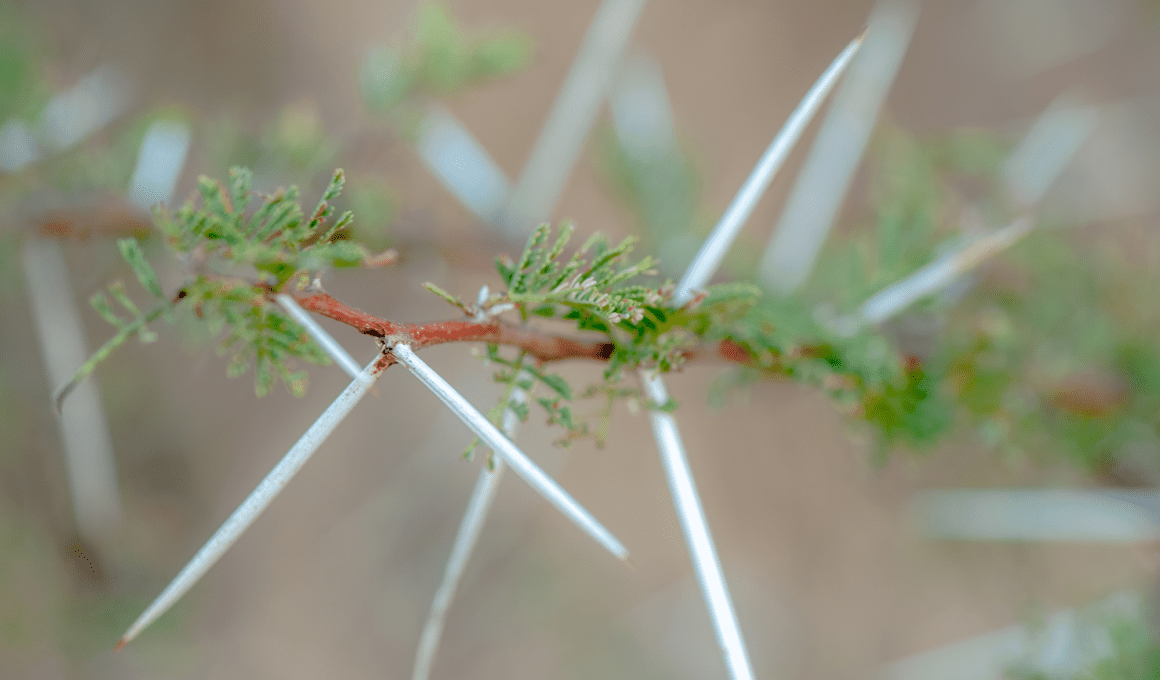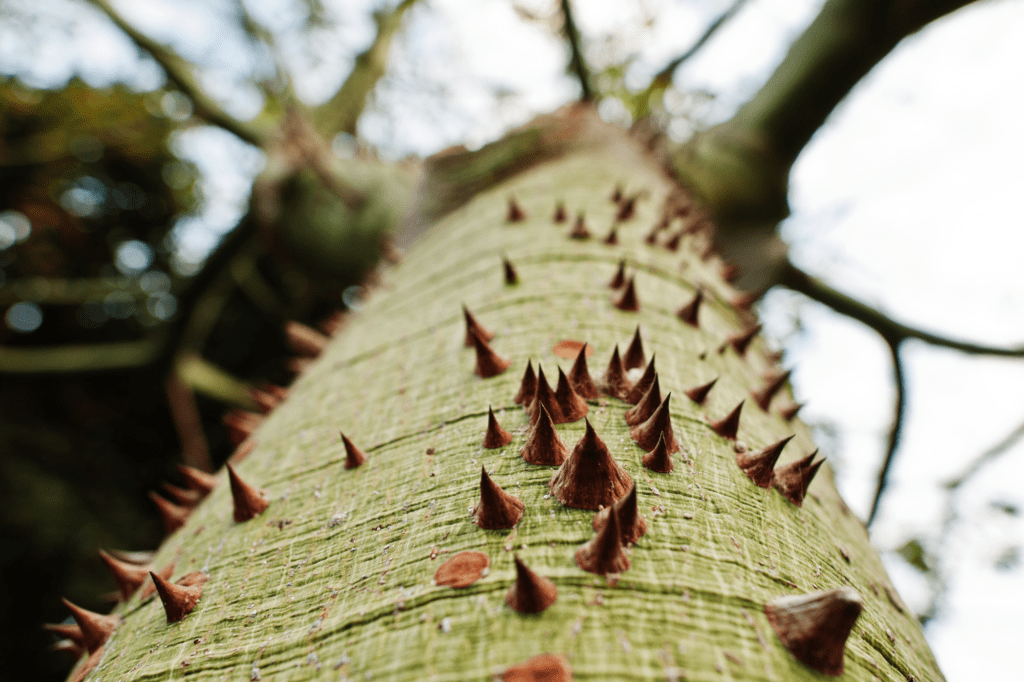Welcome to our guide on trees with thorns, where we will explore the fascinating world of these unique plants. Trees with thorns are an intriguing feature of our natural world, with spiky branches and prickly bark that provide a range of benefits to the ecosystem. In this section, we will introduce you to the different types of trees with thorns, showcasing their diverse characteristics and discussing their ecological significance.
Thorny trees are found in many regions of the world and are known by various names, such as thorny trees, spiky trees, and trees with sharp thorns. They range in size and shape, from towering giants to shrubs that barely reach waist-height.
Despite their prickly exterior, many thorny trees are vital to the ecosystem, providing shelter and nourishment to a variety of wildlife. Some thorny trees produce fruits or nuts that are a valuable food source for animals, while others provide nesting sites for birds and insects.
In the next section, we will discuss the adaptations and characteristics of thorny trees, providing a closer look at how they develop thorns and the role these sharp structures play in their survival.
Understanding Thorny Trees: Adaptations and Characteristics
Thorny trees are unique and fascinating specimens that have developed thorns as an adaptation to protect themselves from predators and environmental threats. These thorns, also known as prickles or spines, can be found in various parts of the tree, such as the bark, branches, or leaves.
One of the most common types of thorny trees is the Acacia. Acacias are native to Africa and are known for their long, sharp thorns that grow on their branches and leaves. The thorns serve as a defense mechanism against herbivores, such as giraffes and elephants, that may try to eat their foliage.
Another type of thorny tree is the Honeylocust, which is native to North America. Honeylocust trees have thorns that grow on their bark and can grow up to six inches long. These thorns are modified branches that help protect the tree from animals that may try to climb it.
Thorny Bark
Some trees have developed thorny bark as a way to protect themselves from predators. The Hawthorn tree, for example, has sharp thorns that grow on its trunk and branches. Hawthorn thorns can grow up to three inches long and are known for being very sharp.
These thorny trees have adapted to harsh environments and are able to survive in areas where other trees may not be able to grow. For example, the Joshua tree, a type of Yucca plant native to the Southwest United States, has evolved to grow long, sharp thorns on its branches to protect itself from animals and extreme weather conditions.
Defense Mechanism
Thorns serve as an essential defense mechanism for thorny trees. They help protect the tree from predators and environmental threats, such as fires or extreme weather conditions. When an animal tries to eat a thorny tree’s leaves or branches, the thorns can cause pain and damage to the predator’s mouth, discouraging it from trying to eat the tree again.
However, thorns are not just used for defense. Some thorny trees, such as the Osage Orange, have been traditionally used by humans for their wood and fruit. The Osage Orange tree has a hard, durable wood that is prized for making bows and other tools. Its fruit, which is covered in thorns, was historically used by Native Americans for medicinal purposes.
“Thorns serve as an essential defense mechanism for thorny trees. They help protect the tree from predators and environmental threats.”
Can Dwarf Fruit Trees Have Thorns Like Other Types of Trees?
Can best dwarf fruit trees have thorns like other types of trees? While most dwarf fruit trees are bred to minimize thorns, some varieties may still carry them. It’s essential to choose carefully when selecting dwarf fruit trees to ensure you find a thornless variety if that is your preference. Thorns may have protective benefits, but for home gardeners seeking convenience, thornless dwarf fruit trees are typically the preferred choice.
Popular Types of Trees with Thorns
If you thought all trees with thorns looked alike, think again. There is a remarkable diversity of thorny trees across the globe, each with its unique features and adaptations.
One such tree is the African acacia, known for its long and sharp thorns that can reach up to 4 inches in length. These thorns provide refuge to ants, which in turn protect the tree from herbivores.
Did you know? The acacia’s thorns are strong enough to puncture through a car tire!
Another popular thorny tree is the hawthorn, commonly found in North America, Europe, and Asia. Hawthorns have small, needle-like thorns that grow along their branches.
Fun fact: The hawthorn is also known as the “bread and cheese tree” because its fruit was a traditional food source for travelers in medieval times.
The silk floss tree is another tree with a unique thorn adaptation. Its thorns are stout and conical, and they grow along its trunk and branches. These thorns are used for defensive purposes, protecting the tree’s sap and making it difficult for animals to climb.
One thorny tree that is commonly found in the United States is the honey locust. This tree has large, branched thorns that can grow up to a foot long. The honey locust is also known for its fast growth and its ability to withstand harsh urban conditions.
Fun fact: The honey locust’s thorns were once used as nails by early settlers.
Other notable trees with thorns include the black locust, holly, and mesquite. Whether you’re exploring the African savannah or walking through a North American forest, keep an eye out for these fascinating trees with thorns.
Thorny Shrubs: A Closer Look
Thorny shrubs are a common sight in many different environments around the world. These plants differ from thorny trees in several ways, including their size, growth habits, and ecological roles. Despite their smaller stature, thorny shrubs can play a significant role in their respective ecosystems.
One example of a thorny shrub is the prickly pear cactus. This plant is well known for its distinctive appearance and prickly spines, which can be found covering its stems and branches. The prickly pear cactus is native to many different regions, including parts of the Americas, Africa, and Australia. It is commonly used in traditional medicine and as a food source for both humans and animals.
Prickly Pear Cactus
| Common Name: | Prickly Pear Cactus |
|---|---|
| Scientific Name: | Opuntia |
| Size: | Varies depending on species, but can range from a few inches to several feet in height |
| Appearance: | Thick, fleshy stems and branches covered in spines; yellow, pink, or red flowers and edible fruit |
| Ecological Role: | Provides food and habitat for a variety of animals; helps control soil erosion |
Another common thorny shrub is the hawthorn. This plant is native to many parts of Europe, Asia, and North America, and is often used in landscaping due to its attractive appearance. The hawthorn produces clusters of white or pink flowers in the spring, followed by small fruits that are popular with birds and other wildlife.
Hawthorn
| Common Name: | Hawthorn |
|---|---|
| Scientific Name: | Crateagus |
| Size: | Varies depending on species, but can range from a few feet to several meters in height |
| Appearance: | Small, deciduous tree or shrub with thorny branches; clusters of white or pink flowers and small red or black fruit |
| Ecological Role: | Provides food and habitat for a variety of animals; used in traditional medicine |
Other thorny shrubs include the blackthorn, the firethorn, and the barberry. Each of these plants has its own unique features and benefits, making them an important part of their respective ecosystems.
Overall, thorny shrubs are a diverse and important group of plants that play a vital role in both natural and human landscapes. Despite their thorns, they provide numerous benefits and are worth getting to know.
Frequently Asked Questions about Trees with Thorns
Trees with thorns can be a fascinating and unique addition to any landscape. However, it’s important to navigate them safely and with caution. Here are some frequently asked questions about trees with thorns, and their answers.
How do I safely remove thorns from my skin?
If you get a thorn stuck in your skin, it’s important to remove it as soon as possible to avoid infection. You can use clean tweezers or a sterilized needle to gently pull the thorn out of your skin. Be sure to clean the area with soap and water and apply a bandage if necessary. If you’re unsure about how to remove a thorn safely, seek medical attention.
Can thorns cause harm to pets or wildlife?
Yes, thorns can be harmful to pets or wildlife. It’s important to keep an eye on your pets while they’re in areas with thorny trees to avoid injury. Additionally, some birds and small animals may use thorny trees as nesting sites or for protection from predators. Try to maintain a balance between preserving thorny trees and ensuring the safety of the local wildlife.
Are thorny trees suitable for my backyard?
It depends on your personal preferences and the size of your backyard. Some thorny trees, like the hawthorn or blackthorn, can make excellent hedge plants for privacy and security. However, other varieties of thorny trees may be too large or unmanageable for small backyards. It’s important to research the different types of thorny trees and their growth habits before planting in your backyard.
Can thorns serve as a form of natural defense for trees?
Yes, thorns can serve as a natural defense mechanism for trees. They can discourage herbivores from eating the leaves or bark of the tree, protecting it from harm. Additionally, thorns can also provide a physical barrier against predators, like large animals or humans. However, it’s important to handle thorny trees with caution and respect, to avoid injury.
Are there any health benefits to using thorns in traditional medicine?
Thorns are sometimes used in traditional medicine practices, but their potential health benefits have not been extensively studied. Some cultures believe that thorns contain anti-inflammatory or antibiotic properties, and they may be used to treat wounds, infections, or other health issues. However, it’s important to consult a healthcare professional before using thorns or any other natural remedies for medicinal purposes.











